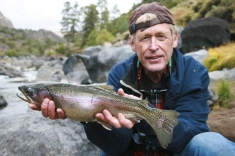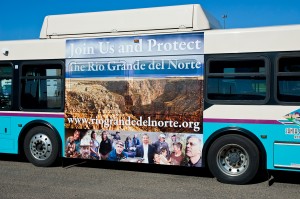Francisco Guevara, a native New Mexican and owner of Los Rios River Runners, explains in the Los Alamos Monitor why the Rio Grande del Norte is so much more than just a river.
There is a well-known saying in the southwest: “Agua es vida,” or “water is life.” This isn’t just a reference to our limited supplies, but also to the cultural, spiritual and economic significance of water to our way of life.
As the owner of a rafting company in Northern New Mexico, water is indeed my life. I take tourists and residents whitewater rafting, camping and fishing while exposing them to the culture, natural beauty and majesty that makes Northern Mexico so special. That’s why I support efforts underway to protect the Rio Grande Gorge as part of a potential Rio Grande del Norte National Conservation Area. But it is also why I was pleased to hear President Obama had designated a new national monument in Colorado recently.
Chimney Rock west of Pagosa Springs isn’t a vital water resource. Instead, its ancient pueblos are held sacred by Native Americans. I’m hoping that if the President is willing to act to recognize and protect the important cultural significance of Chimney Rock, he’ll also act to protect the Rio Grande del Norte, which is sacred to us.
Here in Northern New Mexico, families have irrigated from acequias for hundreds of years. We grow chiles, corn and apples.
We rely on water from the Rio Grande to feed our families, but also to feed our souls.
Ask any local potter, silversmith, writer or painter.
Ask a clergy or tribal member.
Ask any rafter, hunter or angler.
The answer is the same: “Agua es vida.”
In addition to supporting our cultural heritage, the Rio Grande is also the lifeline for many small businesses like mine in rural communities throughout New Mexico. Recreation-based businesses rely on the Rio Grande to support rafting, fishing and hunting trips. Indirectly these activities also support restaurants, lodging, outfitters and guides in addition to contributing to the local tax base. According to the data from the Outdoor Industry Association, more than 100,000 New Mexicans participate in hunting every year, nearly 200,000 in fishing, more than 66,000 in rafting and a whooping 469,000 in wildlife viewing.
That is why there is such a diversity of support for permanent protection of the Rio Grande del Norte. Supporters include business owners, ranchers, sportsmen, veterans, recreationists, elected officials, Native Americans, land grant leaders, and other conservationists.
Ask anyone that had ever been to the Rio Grande gorge, young or old, and they can tell you that this stretch of river and the surrounding area is some of the wildest and most spectacular in the whole state.
It is vital that we work together to preserve it, and we need President Obama’s help.
Legislation to protect the area has been stalled in the U.S. Congress. While our congressional delegation is valiantly working hard to overcome gridlock in Washington, I worry that this opportunity to protect the Rio Grande del Norte, and benefit our state and nation is so many ways, will be lost.
Protecting our water supplies and way of life cannot be put on hold while the U.S. House of Representatives takes yet another run at dismantling our health care or attacking clean energy.
Instead, it is the Rio Grande del Norte that needs our attention, and President Obama’s leadership; nothing less than our culture, economy, and way of life depend on it.
Francisco Guevara is a multigenerational, native northern New Mexican. He has run his rafting business, Los Rios River Runners for more than 40 years.



